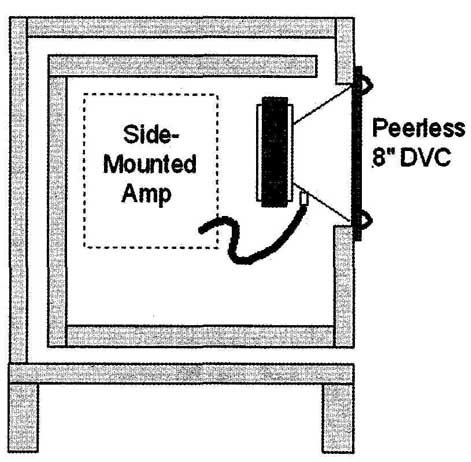|
|
Try this speaker design approach when working with long ports for a small box.
Building a small subwoofer in a ported enclosure can be a challenge. Low resonance drivers with large excursion capabilities in small enclosures re quire long ducts. The larger the duct cross section is to control wind noise from large excursions, the longer it must be. Fitting that duct into a small enclosure becomes a challenge, especially when you might also like to make adjustments during design and construction.

FIGURE 1: Snail tail author’s prototype.

FIGURE 2: Snail tail concept with longer shaded duct.

FIGURE 3: Snail tail concept with longest duct.

PHOTO 1: Sub front driver view.

PHOTO 3: Sub with port bottom removed
After reading how a couple of authors in audioXpress wrestled with that challenge, I came up with the snail tail sub concept. By starting with a shelf port, you can actually wrap the duct around the enclosure like the tail of a snail. You can lengthen or shorten the last segment to adjust the final tuning. With this approach the duct is actually outside of the enclosed volume and doesn’t change effective volume as length changes during tuning.
I built a unit for my own use to test the concept. The unit is 18 x 18” with a 10” width. I started with a Peerless 831858 DVC 8” woofer (Fs = 22) and I coupled it with a Keiga, KG-3100, 2.1 plate amp from Madisound. The plate amp is driven by the preamp section of my Proton D-540 integrated amp and provides the drive for the woofer (50V the crossover (75-150Hz), and also the drive for the PSB Alpha Intro right and left channel speakers (12.5W/channel).
The prototype enclosure has a movable bottom that serves as one side of the 6.5 in port.
The port is over-long at first (17 ¼” and shortened until I be came happy with the sound) before I settled on the final port length of about 14”. I used "foamie" from the WalMart craft section to seal the port bottom. Foamie comes in 8.5" x 11” sheets, is about 1/8" thick, dense foam rubber, and comes with or without peel and stick adhesive on the back. It makes good speaker gaskets, too.
This approach allows for lots of packaging options:
• A front-mounted single driver with the amp on the back (see photos)
• Dual side-mounted drivers with the amp on the front if a longer port is required
• The longest possible port leaves only the enclosure sides for driver and amp mounting. This option could be two drivers on one side with the amp on the other, or drivers on both sides with one or both sharing a side with an amp.
The side-mounted driver option makes the longest and largest ports possible. Figures 1 - 3 show variants with longer and longer ports. As the port becomes longer, the design is reminiscent of the Stromberg-Carlson labyrinth systems of the late 50s and early 60s with their chrome frames and red-coned drivers.
